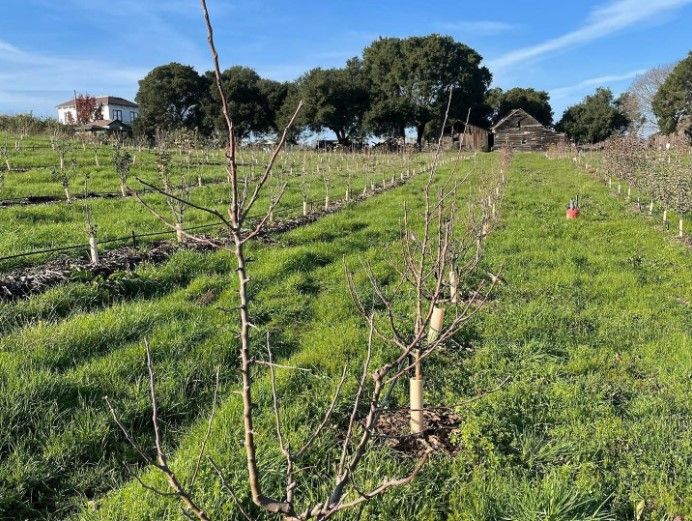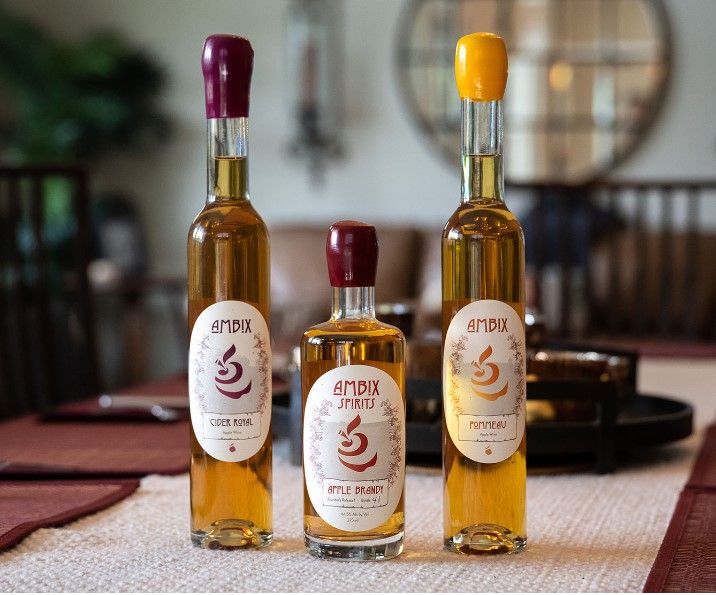Introducing Ambix Spirits

“Surely the apple is the noblest of fruits. Let the most beautiful or the swiftest have it. That should be the 'going' price of apples.” - Henry David Thoreau
America loves apples.
The fleshy, hardy fruit is hard-coded into our national DNA—”as American as apple pie” is more of a battle cry than nostalgia for a regional, seasonal fruit tart. Lighthearted childhood tales of Johnny Appleseed, pot on head and seeds in hand, spreading good will and orchards across the land are just as euphemistic. Appleseed (John Chapman of Leominster, MA) was a land developer, and his apples laid the first infrastructure for westward expansion in a time when weak cider was the universal alternative to bad water.
So, it almost doesn’t make sense that Calvados, the most revered spirit of Normandy, is only now just gaining a toehold in national spirits markets. Pandemic notwithstanding, French apple brandy saw unprecedented growth in 2021 and 2022.
What’s more, there are very few domestic producers who work with apples, and even fewer have the long view you’d need to make a 10-year aged brandy from apple trees that don’t mature for 5 years.
In fact, there might only be one.
David Klein is no stranger to the long game, in fact he embraces it. When he and his wife, Zoe Osborne, founded Ambix Spirits in 2019 with the express purpose of creating Calvados-style apple brandy in Sebastopol, they knew they were in it for the long haul.
“It’s a common saying that you start a brandy company for your grandchildren,” says Klein, “and this venture won’t be fully realized until well after our lifetimes.”
Calvados comes from Normandy, France, and is typically made with cider apples that are high in tannins—not the typically sweet apples found in the grocery store. Klein researches apples from all over the world to find varietals best suited for what might someday be recognized as Sebastopol apple brandy terroir—not an easy task when Klein points out that the Bay Area is a land of micro-climates. He and Osborne planted 1,600 apple trees on their four-acre plot of land, and plan to grow that number to roughly 2,000 over the next five years.

“The weather variation is dramatic within a distance of miles and sub-miles,” says Klein. “I don’t know how things are going to grow, so some of the trees I test out might be reduced to a couple of token trees, because we’re learning. Many of the apples I’ve planted have not been grown in this area before. French and English apple varietals do okay here—not great—while a lot of Virginia-based apples do pretty well.”
For Klein and Osborne, brandy is an agricultural product very much tied to the fruit and the soil, not unlike craft whiskey in the US—a relatively new category still striving to define regionality and terroir for itself. But becoming an orchardist is just one link in the complex and precarious chain that is brandy production, a chain which Klein says is easily broken.
“There’s so much involved, and that’s where our passion lies. It’s not becoming an expert at one thing—the best orchardist or distiller or cider maker—it’s becoming pretty good at a lot of things. Growing your own fruit requires soil management, fertilization, cover crops, training and pruning, how you pick the fruit, how you ferment it, how you select casks, and blend, and market the product.”
Klein and Osborne were home brewers first, experimenting with grains and flavor profiles in the 80s, before the craft beer revolution swept the US. When it became easier to buy a good craft beer in the grocery store than home brew it, Klein and Osborne turned their sights to brandy as a natural, albeit more ambitious, extension of their already impressive garage operations. They were already growing apples successfully in their suburban garden, and when they realized that the craft spirit market had a big brandy-sized hole in it, they decided to fill it with their own take on French Calvados—a serious undertaking requiring significant time, labor, and resources.
A lot of that time is spent outside in the orchard, which Klein embraces. In his estimation, modern humans log something like 50% of their outdoor, sunlit hours before the age of 18, and he’s happy that his budding brandy estate helps him buck that trend.
As scientists with multiple startups under their belts, Klein and Osborne are familiar with the painstaking job of caretaking massively complex systems to create flawless products. In this way, a bottle of well-made brandy and a ground-breaking new medical device are kind of the same. They both relish the logistical and chemical complexities of brandy, so it was a logical transition when the sale of one of their companies provided enough capital to invest in the land, equipment, and (the most difficult investment to quantify) time.
It takes considerable time to nurture an orchard of cider apples into growing enough fruit for a 900-gallon batch of cider (the minimum size required by Ambix’s still). It takes another 40-48 hours to distill the cider to brandy. Klein estimates that his still makes a bottle of brandy about every 20 minutes which is, in his words, “low and slow for sure!”
And then there’s the aging. Klein and Osborne aim to age their brandies for a minimum of 5-10 years before bottling, but as Klein points out, you have to start selling products sometime. The first releases of Ambix brandy, Pommeau, and Cider Royal (all on the market since this spring) are from younger stock. Because the orchard won’t be in full production for a few years, Ambix also buys apple juice from nearby apple farmers (Sebastapol is apple country, after all). Aging and blending locally sourced juice with their own stock and aiming for brandies that are delicious at a relatively young age is part of the short-term plan.

Since Sebastopol is Gravenstein country and proud of it, Ambix works with Gravenstein juice from neighboring farms to produce what Klein describes as precocious, fruit-forward brandies like their Founder’s Release. A blend of these early barrels, Founder’s Release may be fruitier than a traditional Calvados, but it sips more like a rum or Scotch. Alternatively, The Pacific Alchemy brandy combines both pears and apples—a common practice for French Calvados producers—which yields a spirit Klein describes as perfect for cocktails; playful, vibrant, and zingy.
Klein and Osborne offer two other spirits—the Pommeau, a French-style apple aperitif, and the Cider Royal, a not-too-sweet fortified cider akin to a dessert wine.
On weekends, visitors are invited to make appointments for tastings and a peek at the custom-built, hand-hammered Alambic Charentais from Chalvignac Prulho. It took two years to make, but the wait was worthwhile, Klein says. The still creates “an exceptional layered mouth feel with complex fruit and the ability to make a complicated spirit suitable for long term aging.”

Unlike stills with columns, the Alambic Charentais moves at a much slower pace and retains a lot more of the oils and esters that give Ambix’s spirits their signature depth of flavor. “A couple important traits give a unique fingerprint for a Charentais, one being direct fire, which gives additional complexity from the variation in heat in the boiler,” says Klein. “The Chapiteau, which is a bulge above the boiler, allows vapors to swirl and concentrates flavors, and then the swan’s neck smoothly guides the good stuff over to the condenser, so it can be cooled. Alambic Charentais stills are all made by hand—no two are alike, and so the hammering of the copper creates unique flavor fingerprints for every still.”

